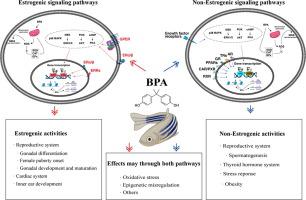Environment International ( IF 10.3 ) Pub Date : 2023-05-16 , DOI: 10.1016/j.envint.2023.107976 Mingzhe Yuan 1 , Shan Chen 2 , Chu Zeng 1 , Yuqin Fan 3 , Wei Ge 1 , Weiting Chen 3

|
Bisphenol A (BPA) is the most simple and predominant component of the Bisphenol family. BPA is widely present in the environment and the human body as a result of its extensive usage in the plastic and epoxy resins of consumer goods like water bottles, food containers, and tableware. Since the 1930s, when BPA’s estrogenic activity was first observed, and it was labeled as a “mimic hormone of E2”, studies on the endocrine-disrupting effects of BPA then have been widely conducted. As a top vertebrate model for genetic and developmental studies, the zebrafish has caught tremendous attention in the past two decades. By using the zebrafish, the negative effects of BPA either through estrogenic signaling pathways or non-estrogenic signaling pathways were largely found. In this review, we tried to draw a full picture of the current state of knowledge on the estrogenic and non-estrogenic effects of BPA with their mechanisms of action through the zebrafish model of the past two decades, which may help to fully understand the endocrine-disrupting effects of BPA and its action mechanism, and give a direction for the future studies.
中文翻译:

双酚 A 的雌激素和非雌激素作用及其在斑马鱼模型中的作用机制:过去二十年工作的概述
双酚 A (BPA) 是双酚家族中最简单和最主要的成分。BPA 广泛存在于环境和人体中,因为它广泛用于水瓶、食品容器和餐具等消费品的塑料和环氧树脂中。自从 1930 年代首次观察到 BPA 的雌激素活性并将其标记为“E2 的模拟激素”以来,关于 BPA 的内分泌干扰作用的研究就得到广泛开展。作为遗传和发育研究的顶级脊椎动物模型,斑马鱼在过去二十年中引起了极大的关注。通过使用斑马鱼,主要发现了 BPA 通过雌激素信号通路或非雌激素信号通路产生的负面影响。在这篇评论中,































 京公网安备 11010802027423号
京公网安备 11010802027423号